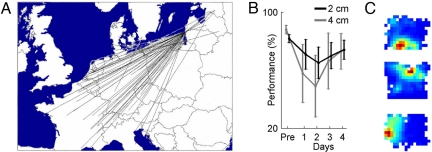Fig. 5.
Spatial memory and navigation in echolocating bats. (A) Example of long-range migration by the bat P. nathusii. Straight lines correspond to individual bats that were banded in Eastern Europe and then recaptured as far as Croatia, Italy, and France (adapted with permission from ref. 54). (B) Spatial memory for 3D flight paths, on the centimeter scale: echolocating bats (M. lyra) were trained to fly through an array of wires, and two bats flew through the wires without touching them on >85% of trials (“pre”); when the wires were moved by 4 or even 2 cm, the bats showed a significant drop in performance on days 1–2, followed by slow recovery. Data were measured from ref. 100 and reanalyzed. Error bars, mean ± SEM, computed over all wire-shift trials in these two bats. (C) Place fields of three “place cells,” recorded from the hippocampus of big brown bats, a small bat species weighing ≈15 g, as the animal was crawling in a rectangular arena (103). Blue color, no spiking activity; red, maximum activity of the neuron (data recorded by N.U.).

